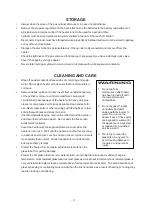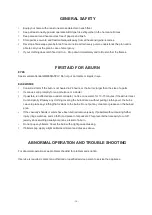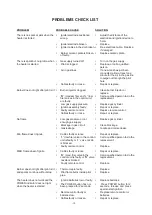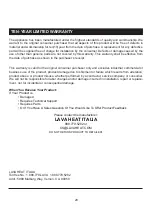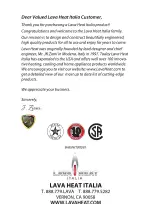
GENERAL SAFETY
%
Equip your home with a least one smoke detector on each floor.
%
Keep at least one dry-powder operative ABC-type fire extinguisher in the home at all times.
%
Keep areas around heat sources free of papers and trash.
%
Store paints, solvents, and flammable liquids away from all heat and ignition sources.
%
Develop a fire-escape plan before a fire occurs. Be certain every person understands the plan and is
able to carry out the plan in case of emergency.
%
If your clothing does catch fire don't run. Drop down immediately and roll to smother the flames.
FIRST AID FOR A BURN
EYES
Seek medical attention IMMEDIATELY. Do not put ointments or liquids in eye.
ELSEWHERE
%
Consult a doctor if the burn is not healed in 24 hours, or the burn is larger than the size of a palm.
%
If serious, send promptly for an ambulance or a doctor.
%
If possible, run affected area under cold water, not ice or ice water, for 10-15 minutes if the skin is intact.
Cut and gently lift away any clothing covering the burned area, without pulling clothing over the burns.
Leave in place any clothing that is stuck to the burns. Do not put any creams or greases on the burned
area.
%
If the casualty's hands or wrists have been burned remove jewelry if possible without causing further
injury (rings, watches, and so forth) and place in his pockets. This prevents the necessity to cut off
jewelry since swelling usually occurs as a result of a burn.
%
Do not pop any blisters. Cover the burn with a light gauze dressing.
%
If blisters pop, apply a light antibiotic ointment and dress as above.
ABNORMAL OPERATION AND TROUBLE SHOOTING
For abnormal operations see problems checklist for problem and solution.
If service is required, contact an authorized or qualified service person to service the appliance.
- 16 -














